[English] 日本語
 Yorodumi
Yorodumi- PDB-6sdz: transthyritin derived amyloid fibril from patient with hereditary... -
+ Open data
Open data
- Basic information
Basic information
| Entry | Database: PDB / ID: 6sdz | ||||||
|---|---|---|---|---|---|---|---|
| Title | transthyritin derived amyloid fibril from patient with hereditary V30M ATTR amyloidosis | ||||||
 Components Components | Transthyretin | ||||||
 Keywords Keywords | PROTEIN FIBRIL / amyloid fibril / systemic ATTR amyloidosis / ex vivo / misfolding / patient tissue / transthyritin | ||||||
| Function / homology |  Function and homology information Function and homology informationRetinoid cycle disease events / The canonical retinoid cycle in rods (twilight vision) / thyroid hormone binding / purine nucleobase metabolic process / Non-integrin membrane-ECM interactions / Retinoid metabolism and transport / hormone activity / azurophil granule lumen / Amyloid fiber formation / Neutrophil degranulation ...Retinoid cycle disease events / The canonical retinoid cycle in rods (twilight vision) / thyroid hormone binding / purine nucleobase metabolic process / Non-integrin membrane-ECM interactions / Retinoid metabolism and transport / hormone activity / azurophil granule lumen / Amyloid fiber formation / Neutrophil degranulation / extracellular space / extracellular exosome / extracellular region / identical protein binding Similarity search - Function | ||||||
| Biological species |  Homo sapiens (human) Homo sapiens (human) | ||||||
| Method | ELECTRON MICROSCOPY / helical reconstruction / cryo EM / Resolution: 2.97 Å | ||||||
 Authors Authors | Fritz, G. / Agarwal, S. / Faendrich, M. | ||||||
| Funding support |  Germany, 1items Germany, 1items
| ||||||
 Citation Citation |  Journal: Nat Commun / Year: 2019 Journal: Nat Commun / Year: 2019Title: Cryo-EM structure of a transthyretin-derived amyloid fibril from a patient with hereditary ATTR amyloidosis. Authors: Matthias Schmidt / Sebastian Wiese / Volkan Adak / Jonas Engler / Shubhangi Agarwal / Günter Fritz / Per Westermark / Martin Zacharias / Marcus Fändrich /   Abstract: ATTR amyloidosis is one of the worldwide most abundant forms of systemic amyloidosis. The disease is caused by the misfolding of transthyretin protein and the formation of amyloid deposits at ...ATTR amyloidosis is one of the worldwide most abundant forms of systemic amyloidosis. The disease is caused by the misfolding of transthyretin protein and the formation of amyloid deposits at different sites within the body. Here, we present a 2.97 Å cryo electron microscopy structure of a fibril purified from the tissue of a patient with hereditary Val30Met ATTR amyloidosis. The fibril consists of a single protofilament that is formed from an N-terminal and a C-terminal fragment of transthyretin. Our structure provides insights into the mechanism of misfolding and implies the formation of an early fibril state from unfolded transthyretin molecules, which upon proteolysis converts into mature ATTR amyloid fibrils. | ||||||
| History |
|
- Structure visualization
Structure visualization
| Movie |
 Movie viewer Movie viewer |
|---|---|
| Structure viewer | Molecule:  Molmil Molmil Jmol/JSmol Jmol/JSmol |
- Downloads & links
Downloads & links
- Download
Download
| PDBx/mmCIF format |  6sdz.cif.gz 6sdz.cif.gz | 201.1 KB | Display |  PDBx/mmCIF format PDBx/mmCIF format |
|---|---|---|---|---|
| PDB format |  pdb6sdz.ent.gz pdb6sdz.ent.gz | 159.9 KB | Display |  PDB format PDB format |
| PDBx/mmJSON format |  6sdz.json.gz 6sdz.json.gz | Tree view |  PDBx/mmJSON format PDBx/mmJSON format | |
| Others |  Other downloads Other downloads |
-Validation report
| Summary document |  6sdz_validation.pdf.gz 6sdz_validation.pdf.gz | 1 MB | Display |  wwPDB validaton report wwPDB validaton report |
|---|---|---|---|---|
| Full document |  6sdz_full_validation.pdf.gz 6sdz_full_validation.pdf.gz | 1.1 MB | Display | |
| Data in XML |  6sdz_validation.xml.gz 6sdz_validation.xml.gz | 39 KB | Display | |
| Data in CIF |  6sdz_validation.cif.gz 6sdz_validation.cif.gz | 61.2 KB | Display | |
| Arichive directory |  https://data.pdbj.org/pub/pdb/validation_reports/sd/6sdz https://data.pdbj.org/pub/pdb/validation_reports/sd/6sdz ftp://data.pdbj.org/pub/pdb/validation_reports/sd/6sdz ftp://data.pdbj.org/pub/pdb/validation_reports/sd/6sdz | HTTPS FTP |
-Related structure data
| Related structure data |  10150MC M: map data used to model this data C: citing same article ( |
|---|---|
| Similar structure data |
- Links
Links
- Assembly
Assembly
| Deposited unit | 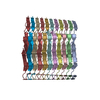
|
|---|---|
| 1 |
|
- Components
Components
| #1: Protein | Mass: 13809.426 Da / Num. of mol.: 11 / Mutation: V30M / Source method: isolated from a natural source Details: transthyritin V30M fragments, residues 11-35 and residues 57-123 Source: (natural)  Homo sapiens (human) / References: UniProt: P02766 Homo sapiens (human) / References: UniProt: P02766 |
|---|
-Experimental details
-Experiment
| Experiment | Method: ELECTRON MICROSCOPY |
|---|---|
| EM experiment | Aggregation state: HELICAL ARRAY / 3D reconstruction method: helical reconstruction |
- Sample preparation
Sample preparation
| Component | Name: Transthyretin derived amyloid fibril (V30M) / Type: COMPLEX / Details: ex vivo ATTR amyloid fibril from human tissue / Entity ID: all / Source: NATURAL |
|---|---|
| Source (natural) | Organism:  Homo sapiens (human) Homo sapiens (human) |
| Buffer solution | pH: 7 / Details: Water extract |
| Specimen | Embedding applied: NO / Shadowing applied: NO / Staining applied: NO / Vitrification applied: YES |
| Specimen support | Grid material: COPPER / Grid mesh size: 400 divisions/in. / Grid type: C-flat-1.2/1.3 4C |
| Vitrification | Instrument: FEI VITROBOT MARK III / Cryogen name: ETHANE / Humidity: 96 % |
- Electron microscopy imaging
Electron microscopy imaging
| Experimental equipment |  Model: Titan Krios / Image courtesy: FEI Company |
|---|---|
| Microscopy | Model: FEI TITAN KRIOS |
| Electron gun | Electron source:  FIELD EMISSION GUN / Accelerating voltage: 300 kV / Illumination mode: FLOOD BEAM FIELD EMISSION GUN / Accelerating voltage: 300 kV / Illumination mode: FLOOD BEAM |
| Electron lens | Mode: BRIGHT FIELD / Cs: 2.7 mm |
| Image recording | Electron dose: 40 e/Å2 / Film or detector model: GATAN K2 SUMMIT (4k x 4k) |
| Image scans | Movie frames/image: 40 |
- Processing
Processing
| Software | Name: PHENIX / Version: 1.15.2_3472: / Classification: refinement | ||||||||||||||||||||||||||||||||||||
|---|---|---|---|---|---|---|---|---|---|---|---|---|---|---|---|---|---|---|---|---|---|---|---|---|---|---|---|---|---|---|---|---|---|---|---|---|---|
| EM software |
| ||||||||||||||||||||||||||||||||||||
| CTF correction | Type: PHASE FLIPPING AND AMPLITUDE CORRECTION | ||||||||||||||||||||||||||||||||||||
| Helical symmerty | Angular rotation/subunit: -1.19 ° / Axial rise/subunit: 4.825 Å / Axial symmetry: C1 | ||||||||||||||||||||||||||||||||||||
| Particle selection | Num. of particles selected: 103663 | ||||||||||||||||||||||||||||||||||||
| 3D reconstruction | Resolution: 2.97 Å / Resolution method: FSC 0.143 CUT-OFF / Num. of particles: 70624 / Algorithm: FOURIER SPACE / Symmetry type: HELICAL | ||||||||||||||||||||||||||||||||||||
| Atomic model building | B value: 89.59 / Protocol: AB INITIO MODEL / Space: RECIPROCAL / Target criteria: Cross-correlation coefficient | ||||||||||||||||||||||||||||||||||||
| Refine LS restraints |
|
 Movie
Movie Controller
Controller



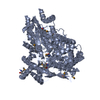
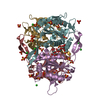
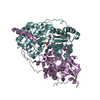

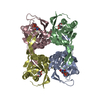

 PDBj
PDBj




